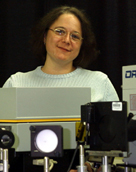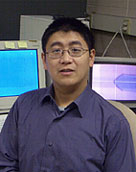Inventor(s): Elizabeth Gaillard, James Dillon
Abstract
Age-related macular degeneration (AMD) is a major cause of visual impairment in older adults. Macular degeneration can make it difficult or impossible to read or recognize faces, although enough peripheral vision remains to allow other activities of daily life. The invention herein provides for a method of detecting and diagnosing symptoms of immune-mediated processes during aging and AMD by detecting the biomarkers 3-nitrotyrosine and nitro-A2E within human Bruch's membrane. The finding of these biomarkers provides the first clear demonstration of non-enzymatic nitration of proteins and age-related deposits (A2E) within human Bruch's membrane. Either or both biomarkers can be detected using different methods such as a non-invasive fluorescence test or resonance Raman, which is performed with common diagnostic instruments with standard diagnostic techniques. Through the use of these biomarkers and fluorescent patterns, detection of AMD and other diseases such as, but not limited to, cirrhosis, arteriosclerosis, and Alzheimer’s disease can be made earlier, allowing a patient to seek treatment as soon as possible. These biomarkers enable non-invasive monitoring of the progression of the disease, as well.
Potential Commercial Use and Users
Ophthalmology, detection and treatment of AMD and other diseases.
Advantages
Diseases are detected non-invasively and diagnosed earlier, and treatment efficacy is determined easily
Related Publications
Murdaugh, L.S., Wang, Z., Del Priore, L.V., Dillon, J., Gaillard, E.R. (2010). Age-related accumulation of 3-nitrotyrosine and nitro-A2E in human Bruch&'s membrane. Experimental Eye Research. 90 (5), 564-571.(Available for viewing through Science Direct)
Murdaugh, L.S., Dillon, J., Gaillard, E.R. (2009). Modifications to the basement membrane protein laminin using glycolaldehyde and A2E: A model for aging in Bruch’s membrane. Experimental Eye Research. 89 (2), 187-192. (Available for viewing through Science Direct)
Status: Patent Pending







